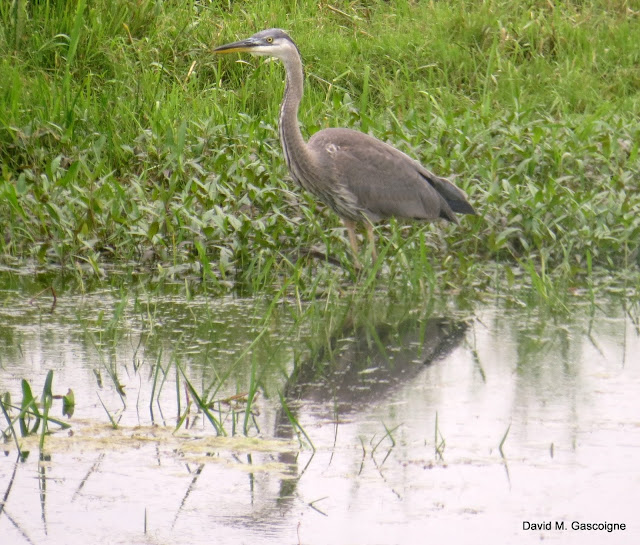As mentioned in my last post most birds are involved with procreation at this time of year, with photographic opportunities relatively scant unless one is near an expanse of water. So, I have focused my efforts of late on wildflowers and the results are shown below.
Birdsfoot Trefoil Lotus corniculatus is not native to this area, but is widespread and irrevocably part of the flora now. It is quite incredible, really, how greatly immigrants to North America longed for the familiar plants of home and brought them here. Some are relatively innocuous, but others have become truly invasive and native vegetation and the wildlife it supports have suffered greatly as a result.
Another introduced species which can be commonly found is Cow Vetch Vicia cracca.
Even though North America has its own buttercup species, I suppose that nothing was considered quite as beautiful as the Common or Tall Buttercup Ranunculus acris and it too was introduced and has multiplied profusely.
Chicory Cichorium intybus was also imported from Europe, perhaps as an ingredient for coffee, and it too has become well established.
The Red Osier Cornus stolonifera, a member of the dogwood family, is native to the area (hooray!) and by now is sporting a full crop of berries.
Queen Anne's Lace Daucus carota is very common and can be found in scrubby, weedy habitats throughout the region.
Common Tansy Tanacetum vulgare is often located alongside Queen Anne's Lace.
In the same locations one may also find Yarrow Achillea millefolium.
Where there are flowers there are butterflies and this Red-spotted Purple Limenitis arthemis atyanax was in very poor condition. It is doubtful that it could function with that kind of wing damage and I suspect that it would quickly become a tasty snack for an insectivorous bird.
The title of my blog is Travels with Birds and so no post would be complete without at least one picture of a bird; here is a Great Blue Heron Ardea herodias patrolling along the river's edge in Hawkesville.
Thursday, July 09, 2015

David M. Gascoigne,
I'm a life long birder. My interests are birds, nature, reading, books, outdoors, travel, food and wine.
you may also like
Subscribe to:
Post Comments (Atom)
Land Acknowledgement
We acknowledge that the land on which we are situated are the lands traditionally used by the Haudenosaunee, Anishinaabe, and Neutral People. We also acknowledge the enduring presence and deep traditional knowledge, laws, and philosophies of the Indigenous Peoples with whom we share this land today. We are all treaty people with a responsibility to honour all our relations.
Followers
Welcome

My name is David. I'm a lifelong birder, fiercely committed to all of nature, however. Married to Miriam Bauman. I love to travel. I Enjoy a good book and a good glass of wine. To read more about me, click my ABOUT page.
Follow by Email
Search This Blog
Blog Archive
Popular Posts
-
I am quite confident in my judgement when I say that nuthatches (Family Sittidae ), small birds with a remarkable ability to scurry dow...
-
22 November, 2025 Leader: David M. Gascoigne Participants: Farid Asey, Heela Asey, Mina Asey, Palwasha Asey, Sameer Asey, Mary Ann Cassidy, ...
-
It has been a long time since I received those annoying, “Fail to publish, please try again later,” notices, but it is happening aga...
-
02 November, 2025 We had been invited to take a stroll though Laurel Creek C.A. with good friends, Dave and Mary, followed by coffee ...
-
29 November, 2025 After a snowy overnight, with everywhere white and glistening, it was a perfect day for an outing with our little Pri...
-
23 October, 2025 Predictably, Mallards ( Anas platyrynchos ) were easily found. You will note just left of centre in the picture...
-
I just returned from a successful and highly enjoyable visit to Colombia with birding friends. We'll all have very fond memories fo...
-
Mere days ago I was having a discussion with a friend about the exclusion of women from so many aspects of society in certain parts o...
-
As I continue to be afforded the great pleasure of leading outings for Waterloo Region Nature, I am offering two options for local de...
-
Of late, there seems to be more and more involved with posting a comment to some blogs, not all by any means, but enough! It is ...





























For a moment there I thought I was taking a walk down Pilling Lane.
ReplyDeleteGood to hear that you're on the straight and narrow after your youthful exuberances. You need to be on your best behaviour when we let you into the UK.
Fantastic photos and details of all these wonderful flowers.
ReplyDeleteBest regards, Synnöve
Depending on the weather and your location in a few weeks time you'll be able to reacquaint yourself with some of these wild flowers in their UK habitats.
ReplyDeleteBeautiful series, David. As being a birder it might be interesting for you to know that Queen Anne's Lace is called Bird's nest (Vogelnestje in Dutch) to the shape when the flower closes during maturation. Great shots of the details.
ReplyDeleteMy favorite picture is the Bumblebee and Chicory. Gr Jan W
Thanks for this great information, Jan. What an appropriate name. Any time now we should be able to get photographs of that stage of the flower's cycle.
ReplyDeleteGlorious series, David!
ReplyDeleteNice shots - I think it is important to let yourself be distracted by things other than birds now and then!
ReplyDeleteCheers - Stewart M - Melbourne
Hello David, beautiful pictures of the flowers.
ReplyDeleteAlso the butterflies are beautiful, that one is very damaged.
Best regards, Irma
Beautiful pictures., David...We have some of those around here as well...Pa. Poor butterfly..looks like her narrowly escaped an attack already..
ReplyDeleteNice variety of pics.. Happy weekend..
ReplyDelete